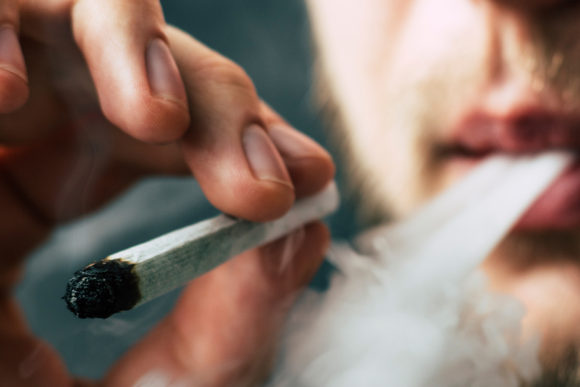Problematic use of marijuana among adolescents and adults increased after legalization of recreational marijuana use, according to a new study from New York University’s Grossman School of Medicine and Columbia University’s Mailman School of Public Health.
Published online November 13 in JAMA Psychiatry, the study claims to be the first to look at the impact of recreational marijuana legalization on both use and cannabis use disorder (commonly referred to as problematic marijuana use) across multiple age groups. Presently, 11 states and Washington, D.C. have legalized marijuana for recreational use while 33 states and D.C. have legalized marijuana for medical use.
After examining usage following the enactment of marijuana legalization in 2012 to 2015, the researchers found that problematic use among adolescents aged 12 to 17 was 25 percent higher (a small increase from 2.18 to 2.72 percent) compared to states without legal recreational use. There was no change in the prevalence of past-month or frequent use among teens.
Among adults aged 26 or older, past-month marijuana use after legalization was 26 percent higher than in non-recreational states. Past-month frequent use rose by 23 percent, and past-year problematic use increased by 37 percent.
Among young adults aged 18 to 25, there was no difference found in past-month, frequent or problematic marijuana use.
“There are, indeed, important social benefits that legalizing marijuana can provide, particularly around issues of equity in criminal justice,” said Magdalena Cerdá, DrPH, associate professor and director of the Center for Opioid Epidemiology and Policy in the Department of Population Health at NYU Langone Health, and the study’s lead author.
“Our findings suggest that as more states move toward legalizing marijuana for recreational use, we also need to think about investing in substance use prevention and treatment to prevent unintended harms—particularly among adolescents,” added Cerdá.
How Study Was Conducted
Cerdá and colleagues analyzed data from the National Survey on Drug Use and Health (NSDUH) with a sample of 505,796 respondents. The investigators specifically looked at data from Colorado, Washington, Alaska and Oregon from 2008-2016, the first four states to legalize marijuana for recreational use, so they could track trends in marijuana use before and after legalization. They compared trends in these four states to trends in states that had not legalized recreational marijuana use. The team examined marijuana use and frequent use (more than 20 days) in the past month, and cannabis use disorder over the past year.
Respondents were classified as having cannabis use disorder based on symptoms corresponding to DSM-IV criteria, which include increased tolerance, repeated attempts to control use or quit, spending a lot of time using, social interpersonal problems due to use, and giving up other activities to use, to name a few.
“Cannabis use disorder in adolescence is associated with long-term adverse health, economic and social consequences,” said Silvia S. Martins, MD, PhD, associate professor of Epidemiology at Columbia University Mailman School of Public Health, director, Center on Policy and Health Initiatives on Opioids and Other Substances (PHIOS), and the study’s senior author.
“Given our findings on problematic use across age groups, legalization efforts should coincide with prevention and treatment. The general public should be informed about both benefits and potential harms of marijuana products to make informed decisions,” Martins added.
To determine if an increase among adolescents could be attributable to other factors besides legalization — such as the introduction of higher-potency cannabis products by the illegal market in the same states that legalized recreational marijuana use — the researchers conducted a sensitivity analysis. They found that if other, unmeasured factors that slightly increased the risk of cannabis use disorder became more prevalent in states that legalized recreational marijuana use at the same time as legalization, those unknown factors could explain the relationship. The extent to which those confounders exist, according to Cerdá, remains unclear and more studies are necessary.
Study Limitations
The researchers identify the study’s limitations. First, findings were reliant on self-reported marijuana use; it is possible that more people may report use following legalization because of increased social acceptability. Secondly, frequency of use and cannabis use disorder are only two aspects of marijuana use.
According to Cerdá and colleagues, future studies should investigate additional measures such as frequency of use within days and THC potency in marijuana products for a more comprehensive assessment of how recreational legalization affects use.
In addition to Cerdá and Martins, study co-authors from Columbia University Mailman School of Public Health include Christine Mauro, PhD, Ava Hamilton, Natalie S. Levy, MPH, Julian Santaella-Tenorio, PhD, Deborah Hasin, PhD, Melanie M. Wall, PhD, and Katherine M. Keyes, PhD.
Funding for the study was provided by the National Institute on Drug Abuse.
Source: NYU Langone Health
Topics Cannabis
Was this article valuable?
Here are more articles you may enjoy.



 Four in New Jersey Face Charges in Alleged $250K Travel Insurance Scam
Four in New Jersey Face Charges in Alleged $250K Travel Insurance Scam  CRC Group Signs Agreement to Acquire Euclid Transactional
CRC Group Signs Agreement to Acquire Euclid Transactional  Howden US Tells Judge Brown & Brown Employees Fled Due to ‘Mistreatment’
Howden US Tells Judge Brown & Brown Employees Fled Due to ‘Mistreatment’  Freight Broker Says $400K in Lobster Meat Stolen in Fictitious Pickup
Freight Broker Says $400K in Lobster Meat Stolen in Fictitious Pickup 

